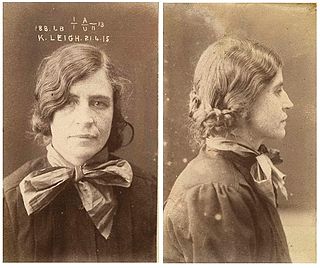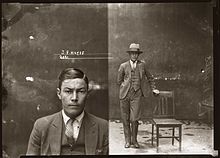The Melbourne gangland killings were the murders of 36 underworld figures in Melbourne, Victoria, Australia, between January 1998 and August 2010. The murders were retributive killings involving underworld groups. The deaths caused a power vacuum within Melbourne's criminal community, and rival factions fought for control and influence. Many of the murders remain unsolved, although detectives from the Purana Taskforce believe that Carl Williams was responsible for at least ten of them. The period culminated in the arrest of Williams, who pleaded guilty on 28 February 2007 to three of the murders.
This is a timeline of major crimes in Australia.
The Shark Arm case refers to a series of incidents that began in Sydney, Australia, on 25 April 1935 when a human arm was regurgitated by a captive 3.5-metre tiger shark, resulting subsequently in a murder investigation and trial.
Leonard Arthur McPherson was one of the most notorious and powerful Australian career criminals of the late 20th century. McPherson is believed to have controlled most of Sydney's organised crime activity for several decades, alongside his contemporary Abe Saffron and associate, bookmaker George Freeman.
Ray "Gunner" Kelly, MBE, was an Australian police officer who was a detective inspector with NSW Police, he became famous during his career owing to his high-profile cases and results, but who was later alleged to have been deeply involved in corruption and organised crime.
William Charles Jenkings was an Australian writer, newspaper reporter, and a well known Bondi Beach personality.

Abraham Gilbert Saffron was an Australian murderer, hotelier, nightclub owner, and property developer who was one of the major figures in organised crime in Australia in the latter half of the 20th century.

Matilda Mary Devine, known as Tilly Devine, was an English Australian organised crime boss. She was involved in a wide range of activities, including sly-grog, razor gangs, and prostitution, and became a famous folk figure in Sydney during the interwar years.

Kathleen Mary Josephine Leigh was an Australian underworld figure who rose to prominence as a madam, illegal trader of alcohol and cocaine, and for running betting/gambling syndicates from her home in Surry Hills, Sydney, Australia during the first half of the twentieth century. Leigh, known as the ‘Queen of Surry Hills’, was a sly groger and fence for stolen property.
Darcy Ezekiel Dugan was an Australian bank robber and New South Wales' most notorious prison escaper. During his criminal career he committed numerous armed holdups, mostly of banks, but also even of a hospital. However, he became more famous for his daring escapes than for his the crimes for which he was convicted.
Murray Stewart Riley was an Australian Olympic rowing athlete, who, after leaving a career as a police officer, gained notoriety as a criminal. Riley represented Australia at the 1952 and 1956 Summer Olympics in double scull rowing, winning a bronze medal in 1956. He served as a police officer in Sydney from 1943 until 1962, when he resigned after disciplinary charges were leveled against him. After his resignation from the police, Riley embarked on a criminal career that included convictions for drug trafficking and fraud. He was implicated in the Nugan Hand Bank scandal and associated with leading figures in the American Mafia, including Jimmy Fratianno of the Los Angeles crime family and corrupt Teamsters official Michael Rudy Tham. He died in 2020 at the age of 94.

George David Freeman was an Australian bookmaker, racing identity and illegal casino operator. He was linked to the Sydney drug trade during the 1970s and 1980s, was named in several Royal Commissions into organised crime and had links with American crime figures. Freeman served several prison terms for theft between 1951 and 1968 but was never brought to trial for any of his later alleged crimes, receiving only monetary fines for SP bookmaking in the mid-1980s. Freeman survived a murder attempt in 1979, was married twice, published an autobiography and died in 1990 of heart failure related to asthma and pethidine addiction.
Underbelly: Razor, the fourth series of the Australian Nine Network crime drama anthology series Underbelly, originally aired from 21 August 2011 to 6 November 2011. It is a thirteen-part series detailing real events that occurred in Sydney between 1927 and 1936. The series depicts the "razor gangs" who controlled the city's underworld during the era and the violent war between the two "vice queen" powers, Tilly Devine and Kate Leigh. It is also the last season in the Underbelly franchise that contains 13 episodes. In contrast to the previous Underbelly instalments, which were based on books by John Silvester and Andrew Rule, Razor is based on the Ned Kelly Award-winning book of the same name, written by Larry Writer.

Nellie Cameron, known as "The Kiss of Death Girl", was a notorious Sydney prostitute in the 1920s and 1930s, who was featured extensively in the 2011 Australian television mini-series Underbelly: Razor. Cameron was associated with the cocaine-fuelled ravages of the razor gang violence of that era, commonly associated with her contemporaries Tilly Devine and Kate Leigh, both criminal entrepreneurs who controlled much of Sydney's illegal sex industry and Sly-grog distribution during that period. Nellie Cameron received 73 criminal convictions during her life of crime, mainly for soliciting and vagrancy, and had the distinction of becoming the first woman in Australia to be convicted of consorting with criminals.

Dulcie May Markham was a prominent Sydney prostitute and associate of gangland figures in Sydney during the 1930s, 1940's and 1950s, when she was closely involved with the razor gang milieu of that era of organised crime within that city. During her criminal career, she had amassed 100 convictions in New South Wales, Victoria, Queensland and Western Australia for prostitution, vagrancy, consorting, assaulting police and the public, keeping a brothel, drunkenness, and drunk driving, and was sent to prison on numerous occasions. Markham was known in the media as The Angel of Death, The Black Widow, Pretty Dulcie, Australia's most beautiful bad woman, Bad Luck Doll, and The One-Way Ticket.

William Joseph Hollebone, known informally as 'Joey' Hollebone, was a notorious and violent member of the criminal underworld, based in the inter-city suburbs of Sydney, Australia. Hollebone began serving a decade-long sentence for manslaughter in 1935, during which he met 'Chow' Hayes. From the mid-1940s to the mid-1950s Hollebone and Hayes were the best-known and feared of Sydney's criminal gunmen, with newspapers regularly reporting on their nefarious activities.

Norman Bruhn was a notorious and violent Australian dockworker, armed robber and standover man with links to the criminal underworld in both Melbourne and Sydney. In September 1926 Bruhn relocated with his family from Melbourne to Sydney, where he attained a brief ascendancy by targeting the underworld vice trade, using violence and intimidation against cocaine traffickers, prostitutes and thieves. Bruhn's criminal gang used the straight razor as a weapon of terror and are attributed as Australia's first 'razor gang', at the beginning of a period of gang violence in Sydney in the late-1920s known as the 'razor gang wars'. His period of domination of the inner-city vice economy was opposed by the more established criminal networks in Sydney. In June 1927 Bruhn was shot twice in the abdomen in an inner-city laneway in Darlinghurst. He died in Sydney Hospital the following morning, refusing to name his assailant.
Criminal activity in New South Wales, Australia is combated by the New South Wales Police Force and the New South Wales court system, while statistics about crime are managed by the Bureau of Crime Statistics and Research. Modern Australian states and cities, including New South Wales, have some of the lowest crime rates recorded globally with Australia ranked the 13th safest nation and Sydney ranked the 5th safest city globally. As of September 2018 the City of Penrith (475.7) and City of Blacktown (495.1). Rural areas have comparatively high crime rates per 100,000 with rural shires such as Walgett Shire (1350.3) and Moree Plains Shire (1236.2) having some of the highest violent crime rates in the state. The overall NSW crime rate has been in steady decline for many years.
The Sydney gangland wars were a series of murders and killings of several known criminal figures and their associates that took place in Sydney, Australia, during the 1980s. A vast majority of the murders were seen as retributive killings, attempts to control Sydney's drug trade, and expansion of criminal territory. A significant number of the murders that took place during the Sydney gangland war went unsolved, mainly due to corrupt police and their association with members of the Sydney Underworld.

George Frederick Amsberg was an Australian barrister and judge of the District Court of New South Wales. He was a prominent member of the Sydney Jewish community. In his legal practice Amsberg defended some of Sydney's most high-profile criminals. In 1953, after becoming a judge, Amsberg was appointed as a Commissioner to preside over the highly political Royal Commission of Inquiry into the conduct of Joshua Arthur, a New South Wales government minister.









